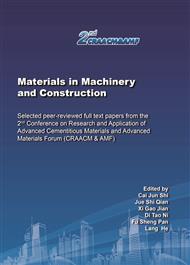p.327
p.337
p.347
p.358
p.371
p.378
p.386
p.395
p.402
Application of Advanced Composite Cementitious Materials and High Performance Admixtures in High Performance Shotcrete
Abstract:
In this paper, the influence of liquid alkali-free accelerator and advanced composite cementitious materials on the mechanical properties, durability and workability of shotcrete was studied. The important role of the two materials in the performance improvement of shotcrete was clarified. The technical measures proposed were verified by field test. The results show that: In terms of workability, the composite use of alkali-free accelerator and functional admixture can achieve fast setting and high early strength of shotcrete, thus effectively reducing the rebound rate; In terms of mechanical properties, functional admixture can effectively improve the early mechanical properties of shotcrete, while alkali-free accelerator can ensure the long-term development of mechanical properties; In terms of durability, the use of functional admixtures can effectively improve the compactness of shotcrete, and the test results of 56d electric flux are lower than 1000C.
Info:
Periodical:
Pages:
371-377
Citation:
Online since:
June 2021
Authors:
Price:
Сopyright:
© 2021 Trans Tech Publications Ltd. All Rights Reserved
Share:
Citation:


